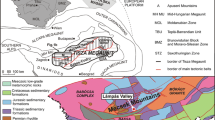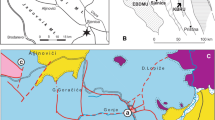Abstract
A silicite horizon corresponding to the global catastrophic event at the Cretaceous–Paleogene boundary was found for the first time in the flysch sequence of the Shapsug section on the southern slope of the Northwest Caucasus. Assemblages of radiolarians and planktonic foraminifers dating the host beds were identified. Mineralogical and analytical data support the presence of tectites, impact minerals, and increased iridium content in the boundary bed of the studied section.




Similar content being viewed by others
REFERENCES
Adamia, Sh., Salukvadze, N., Nazarov, M., et al., Geological events at the Cretaceous–Paleocene boundary in Georgia (Caucasus), Geol. Carpat., vol. 23, no. 3, pp. 35–43.
Afanasiev, S.L., Geologiya Zapadnogo Kavkaza (Geology of Western Caucasus), Moscow: Voentekhizdat, 2004.
Alekseev, A.S., Barsukova, L.D., Kolesov, G.M., et al., Cretaceous/Tertiary event: Iridium distribution in Turkmenia sections, in Abstr. Papers 17th Sci. Conf. Lunar Planet, 1986, Part 1, pp. 9–10.
Alekseev, A.S., Nazarov, M.A., Barsukova, L.D., et al., The Cretaceous–Paleogene boundary in the south of Turkmenia and its geochemical characteristics, Byull. Mosk. Obshch. Ispyt. Prir. Otd. Geol., 1988, vol. 63, no. 2, pp. 55–69.
Alekseev, A.S., Beniamovsky, V.N., Kochergin, D.V., and Kopaevich, L.F., The first find of tegulatoid inoceramid in the Maastrichtian of the Novorossiysk area (Northwestern Caucasus), Byull. Mosk. Obshch. Ispyt. Prir. Otd. Geol., 2018, vol. 93, no. 3, pp. 26–32.
Alvarez, L.W., Alvarez, W., Asaro, F., and Michel, H.V., Extraterrestrial cause for the Cretaceous–Tertiary extinction, Science. New Ser., 1980, vol. 208, pp. 1095–1108.
Bouma, A.H., Ancient and recent turbidites, Geol. Mijnbouw. E, 1964, no. 43, pp. 375–379.
Ding. L., Paleocene deep-water sediments and radiolarian faunas: Implication for evolution of Yarlung-Zangbo foreland basin, Southern Tibet, Sci. China (Ser. D), 2003, vol. 46, no. 1, pp. 84–96.
Grachev, A.F., Korchagin, O.A., Tsel’movich, V.A., and Kollmann, Kh.A., Cosmic dust and micrometeorites in the transitional clay layer at the Cretaceous–Paleogene boundary in the Gams Section (Eastern Alps): Morphology and chemical composition, Izv., Phys. Solid Earth, 2008, vol. 44, no. 7, pp. 555–569.
Hollis, C.J., Latest Cretaceous to Late Paleocene radiolarian biostratigraphy: A new zonation from the New Zealand region, Mar. Micropaleontol., 1993, vol. 21, pp. 295–327.
Kano, H., Paleocene and Eocene radiolarians from the Domeki formation, Shikoku, Southwest Japan, News Osaka Micropaleontol. (NOM), 2001, spec. vol. 12, pp. 321–336.
Keller, G., Adatte, T., Hollis, C., et al., The Cretaceous/Tertiary boundary event in Ecuador educed biotic effects due to eastern boundary current setting, Mar. Micropaleontol., 1997, vol. 31, pp. 97–133.
Kochergin, D.V., The significance of Paleocene radiolarians of the Northwestern Caucasus for stratigraphy and paleogeographic reconstructions of the basin, in Integrativnaya paleontologiya: perspektivy razvitiya dlya geologicheskikh tselei. Mater. LXIII Sess. Paleontol. O-va Ross. Akad. Nauk (Proc. LXIII Sess. Paleontol. Soc. Russ. Acad. Sci. “Integrative Paleontology: Prospective Geological Applications”), St. Petersburg, 2017, pp. 80–82.
Korchagin, O.A. and Tsel’movich, V.A., Cosmic particles (micrometeorites) and nanospheres from the Cretaceous–Paleogene (K/T) boundary clay bed at the Stevns Klint Section, Denmark, Dokl. Earth Sci., 2011, vol. 437, pp. 449–454.
Muramatsu, T., Late Cretaceous–earliest Paleogene? radiolarians from the Shimanto Belt (Northern Belt) in the southern part of the Akaishi Mountains, central Japan, J. Geol. Soc. Japan, 1986, vol. 92, no. 4, pp. 311–313.
Naydin, D.P., Kopaevich, L.F., Moskvin, M.M., et al., Macropaleontologic characteristics of the Maastrichtian and Danian in Mangyshlak’s uninterrupted sections, Izv. Akad. Nauk. Ser. Geol., 1990, no. 11, pp. 17–25.
Nazarov, M.A., Barsukova, L.D., Kolesov, G.M., et al., The origin of iridium anomaly at the Maastrichtian–Danian boundary, Geokhimiya, 1983, no. 8, pp. 1160–1166.
Nazarov, M.A., Barsukova, L.D., Kolesov, G.M., et al., Cretaceous/Tertiary event: geochemistry of Turkmenia K/T sections, in Lunar Planet. Sci. Conf. 17th. Abstr. Pap., 1986, Pt 1, pp. 605–606.
Olsson, R.K., Hemleben, C., Berggren, W.A., and Huber, B.T., Atlas of Paleocene Planktonic Foraminifera, Washington, DC: Smithson. Inst. Press, 1999.
Savelieva, O.L. and Saveliev, D.P., The origin of an anomaly of iridium and other platinum group elements at different stratigraphic levels, Vestn. KRAUNTs. Nauki Zemle, 2016, no. 4, Iss. 32, pp. 73–87.
Sawlowicz, Z., Iridium and other platinum-group elements as geochemical markers in sedimentary environments, Palaeogeogr., Palaeoclimatol., Palaeoecol., 1993, vol. 104, pp. 253–270.
Strong, C.P., Hollis, C.J., and Wilson, G.J., Foraminiferal, radiolarian and dinoflagellate biostratigraphy of Late Cretaceous to Middle Eocene pelagic sediments (Muzzle Group), Mead Stream, Marlborough, New Zealand, N. Z. J. Geol. Geophys., 1995, vol. 38, pp. 171–212.
Tsel’movich, V.A., Grachev, F.F., and Korchagin, O.A., The first discovery of silica glass in the transition bed at the Cretaceous and Paleogene boundary in the Gams section (Eastern Alps), in Tr. Mezhd. konf. 100 let Tungusskomu fenomenu (26–28 iyunya, 2008 g., Moskva) (Proc. Int. Conf. “Centenary of Tunguska Phenomenon: Past, Present, and Future, Moscow, June 26–28, 2008), Moscow: Ross. Akad. Nauk, 2008, pp. 221–222.
Veimarn, A.B., Naidin, D.P., Kopaevich, L.F., et al., Metody analiza global’nykh katastroficheskikh sobytii pri detal’nykh stratigraficheskikh issledovaniyakh. Metodicheskie rekomendatsii (Methods for Analyzing the Global Catastrophic Events in Detailed Stratigraphic Studies. Methodological Recommendations), Moscow: Mosk. Gos. Univ., 1998.
ACKNOWLEDGMENTS
We are grateful to A.S. Alekseev (Moscow State University, Paleontological Institute, Russian Academy of Sciences) for valuable consultations during the identification of planktonic foraminifera and discussion of the problem in general. We remember with warmth and gratitude the dearly departed outstanding micropaleontologist V.N. Beniamovsky, who studied planktonic foraminifera of the Shapsug section.
Funding
This work was supported by ongoing institutional funding. No additional grants to carry out or direct this particular research were obtained.
Author information
Authors and Affiliations
Corresponding author
Ethics declarations
CONFLICT OF INTEREST
The authors of this work declare that they have no conflicts of interest.
ETHICS APPROVAL AND CONSENT TO PARTICIPATE
This work does not contain any studies involving human or animal subjects.
Additional information
Translated by D. Voroshchuk
Publisher’s Note.
Pleiades Publishing remains neutral with regard to jurisdictional claims in published maps and institutional affiliations.
Rights and permissions
About this article
Cite this article
Kochergin, D.V., Granovskaya, N.V. The Cretaceous–Paleogene Boundary in the Shapsug Section (Southern Slope of the Northwestern Caucasus). Paleontol. J. 58, 245–252 (2024). https://doi.org/10.1134/S0031030123600270
Received:
Revised:
Accepted:
Published:
Issue Date:
DOI: https://doi.org/10.1134/S0031030123600270




